Unit 3《Back to the past》Project教案3(牛津译林版必修3)
牛津译林版高中英语模块3 Unit 3 Back to the past Period 3 教学设计
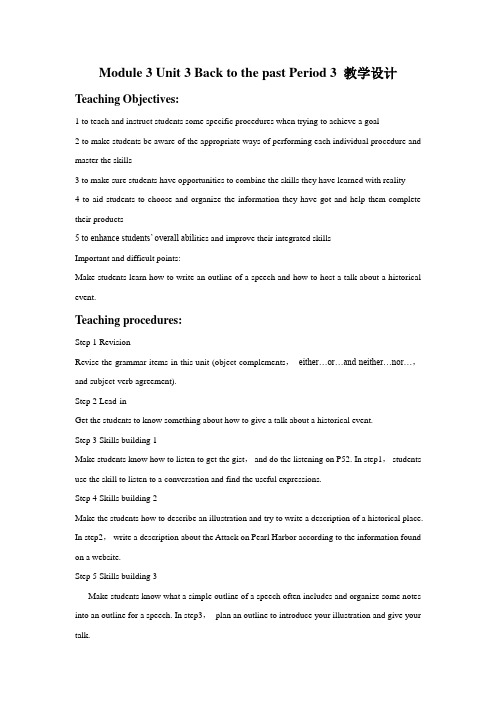
Module 3 Unit 3 Back to the past Period 3 教学设计Teaching Objectives:1 to teach and instruct students some specific procedures when trying to achieve a goal2 to make students be aware of the appropriate ways of performing each individual procedure and master the skills3 to make sure students have opportunities to combine the skills they have learned with reality4 to aid students to choose and organize the information they have got and help them complete their products5 to enhance students’ overall abil ities and improve their integrated skillsImportant and difficult points:Make students learn how to write an outline of a speech and how to host a talk about a historical event.Teaching procedures:Step 1 RevisionRevise the grammar items in this unit (object complements,either…or…and neither…nor…,and subject-verb agreement).Step 2 Lead-inGet the students to know something about how to give a talk about a historical event.Step 3 Skills building 1Make students know how to listen to get the gist,and do the listening on P52. In step1,students use the skill to listen to a conversation and find the useful expressions.Step 4 Skills building 2Make the students how to describe an illustration and try to write a description of a historical place. In step2,write a description about the Attack on Pearl Harbor according to the information found on a website.Step 5 Skills building 3Make students know what a simple outline of a speech often includes and organize some notes into an outline for a speech. In step3,plan an outline to introduce your illustration and give your talk.Project Creating an illustrated time chartAncient China and RomeStep 1 ReadingRead the article and try to get the main idea of each paragraphParagraph 1 main event in Rome and China between 753 BC and 479 BC.Paragraph 2 Similarities between China and Rome during the Han Dynasty.Paragraph 3 Both Rome and China influenced areas between 212 BC and 100 BC. Paragraph 4 Rome and China had a difficult time in the following hundred years.Read the article again and answer the following questions:1. When did Rome become a republic and what happened in China then?2. When was China united and by whom?3. Which city did Han Dynasty have as its capital? Where is it now?4. What did China and Rome have in common during the Han Dynasty?5. When was Silk Road was in use? And what was it used for?6. When did the trade between China and Rome begin? What goods were traded?7. When did Han Dynasty fall and what did it result in?8.When was Roman Empire ended? Was it the same story for China?Step 2 Language study1. In 753 BC,the city of Rome was founded,an d in 509,it became a republic.2. Fifteen years later the Qin dynasty was overthrown,and the Han Dynasty was founded with Chang’an as its capital city.重点讲解“With +宾语+ 宾补”的用法。
高中英语Unit3BacktothepastProject教学设计2牛津译林版必修3
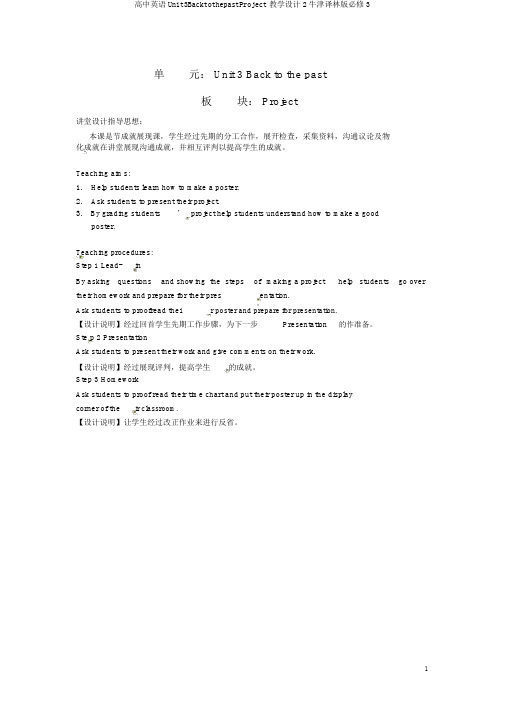
高中英语Unit3BacktothepastProject教学设计2牛津译林版必修3单元: Unit 3 Back to the past板块: Project讲堂设计指导思想:本课是节成就展现课,学生经过先期的分工合作,展开检查,采集资料,沟通议论及物化成就在讲堂展现沟通成就,并相互评判以提高学生的成就。
Teaching aims:1.Help students learn how to make a poster.2.Ask students to present their project.3.By grading students’project help students understand how to make a goodposter.Teaching procedures:Step 1 Lead-inBy asking questions and showing the steps of making a project help students go over their homework and prepare for their pres entation.Ask students to proofread thei r poster and prepare for presentation.【设计说明】经过回首学生先期工作步骤,为下一步Presentation的作准备。
Ste p 2 PresentationAsk students to present their work and give comments on their work.【设计说明】经过展现评判,提高学生的成就。
Step 3 HomeworkAsk students to proof read their time chart and put their poster up in the displaycorner of the ir classroom.【设计说明】让学生经过改正作业来进行反省。
英语:unit3back to the past-reading教案(牛津译林版必修3)
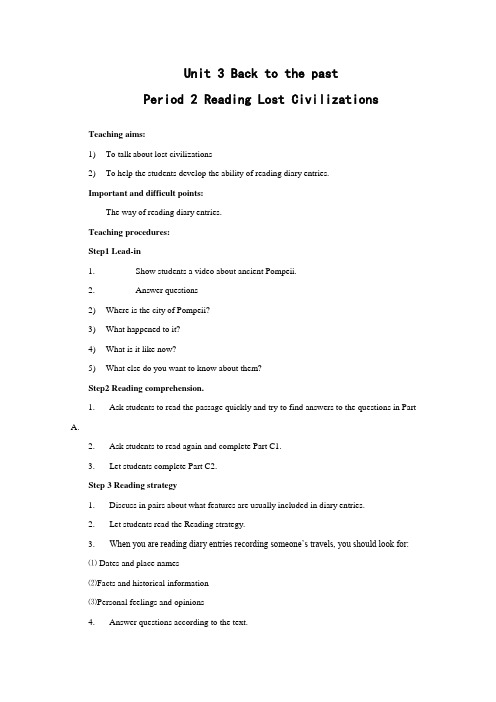
Unit 3 Back to the pastPeriod 2 Reading Lost CivilizationsTeaching aims:1) To talk about lost civilizations2) To help the students develop the ability of reading diary entries.Important and difficult points:The way of reading diary entries.Teaching procedures:Step1Lead-in1. Show students a video about ancient Pompeii.2. Answer questions2) Where is the city of Pompeii?3) What happened to it?4) What is it like now?5) What else do you want to know about them?Step2 Reading comprehension.1. Ask students to read the passage quickly and try to find answers to the questions in PartA.2. Ask students to read again and complete Part C1.3. Let students complete Part C2.Step 3 Reading strategy1. Discuss in pairs about what features are usually included in diary entries.2. Let students read the Reading strategy.3. When you are reading diary entries recording someone’s travels, you should look for:⑴ Dates and place names⑵Facts and historical information⑶Personal feelings and opinions4. Answer questions according to the text.Step 4 Discussion1. Is it useful for people to study things from the past? Why or why not?2. Since as long ago as 1553 people have said, ‘History repeats itself.’ What do you think this saying means? Do you agree with it? Why or why not?Step 5Homework.1. Read the passage carefully and review the new words and phrases.2. Make a summary of the text.Period 3 Reading (2)Teaching Objectives:1)To understand the text better2)To master some useful words and expressionsImportant and difficult points:Some useful words and expressionsTeaching procedures:Step 1 Check the homework.Step 2 Complete the summary with proper words.Both Pompeii in ________and Loulan in China became ____ ________ about 2000 years ago. Pompeii was ________ in the 8th century BC and was _____ _______ by the Romans in 89BC. On 24th Aug.AD79, Mount Vesuvius _________ and the city were _______ __________. Loulan was a _________ _________ on the Silk Road. It disappeared under the ________. There are just a few_________ left. Some _________, such as coins and painted pots, was found.Step 3 language study• 1. A British society arranged for ten high school students from different countries to go on a cultural expedition to sites of lost civilizations. arrange v. 安排,筹划,整理,布置•arrange + n. + for + n. 为…安排…•arrange + for + n. + to do 安排…做…•arrange + (with + n.) + to do (与人)约定干…•arrange + that clause(从句用should + v.) 商定…, 安排…•I arranged to meet him at 6 o’clock.•我约定在6点钟跟他见面.•The secretary ______ ______ the manager.•秘书替我向经理预约.•I’ve _______ for him ________ her.•我已安排他跟她见面.•He arranged that the meeting _______ off for a week.•他安排把会议延后一星期召开.• 2. I am representing Canada. I feel lucky to have won a place on this trip.•我代表加拿大。
高中英语 Unit3 Back to the past project教案 牛津译林版必修3

M3U3 Back to the pastPeriod 6 Project一.【设计思想】要求学生以小组合作、探究的活动形式用英语思维获取信息并处理问题。
二.【教学目标】1.让学生了解著名的历史人物以及他们的成就。
2.训练学生用英语自己制作一个以历史上著名人物为主的海报。
三.【教学重难点】1.如何让学生学会制作海报。
2.让学生掌握文章中的重点单词、短语及句型。
四【教学环节】【课堂教与学】Step1: Lead-inShare pictures about some famous historical figures.Step2: Reading1.Read Text One and finish the task-based reading.2. Read Text Two and fill the blanks.The 1.___________of Western philosophyStep3:Making a poster about a historical figure.Students work in groups to make a poster about Alexander the Great. Tips: 1 What do you know about Alexander the Great’s short life?2 What contributions did he make to the world?3 What do you think of Alexander the Great and his battle?Step4:Show timeStep5:Language points1.(Line4.) researchers explained that no doubt this was a result of …. no doubt无疑,很有可能(doubt在此为名词)他能按时来是毫无疑问的。
江苏省高中英语 Unit3 Back to the past教案 牛津译林版必修3

M3U3 Back to the pastPeriod4 Grammar and usage一、【设计思想】通过讨论和总结等方式,激发学生获取知识的兴趣,在潜移默化中掌握该部分的语法知识。
二、【教学目标】1.学生要掌握宾语补足语的概念以及可以在句中充当宾语补足语的成分。
2.帮助学生了解主谓一致的概念和用法。
三.【教学重难点】如何使学生能够准确地判断出在句中充当宾语补足语的不同成分以及如何正确地使用主谓一致原则。
四【教学环节】【课堂教与学】一、宾语补足语。
Step1: Introduction to Object Complement.1.Don’t keep the door open all night.2.We all consider him a good leader.3.He made me repeat this sentence.4.He asked me to carry the box for him.5.We found a beggar lying on the river bank.6.Tom had his leg broken yesterday.总结:上述句中划线部分均充当_______________ , 其的作用是________________,常见的形式有________、________、________、__________、__________、____________。
宾语补足语的基本结构为___________________。
Step2: The functions of Object Complement.1.名词e.g. They named their daughter Jenny.【Tips】①常用名词充当宾语补足语的动词有:call, name, elect, make, think, appoint, choose, find, consider, keep, wish, feel等。
Unit 3 Back to the past Project 教学设计3-优质公开课-译林版必修3精品
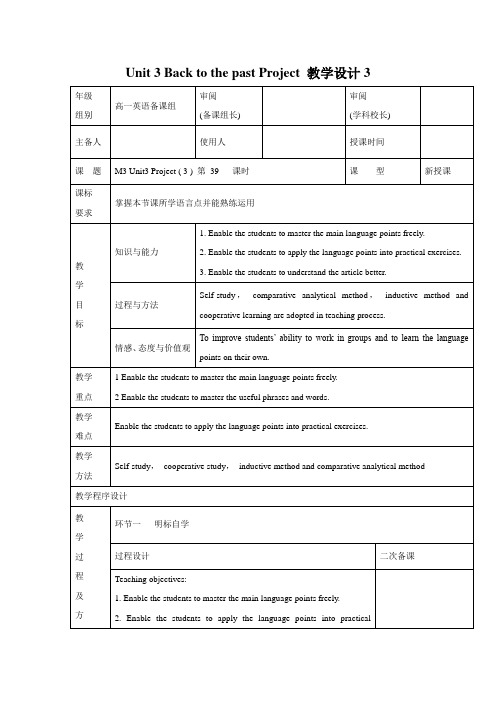
To improve students’ ability to work in groups and to learn the language points on their own.
教学
重点
1 Enable the students to master the main language points freely.
教学程序设计
教
学
过
程
及
方
法
环节一明标自学
过程设计
二次备课
Teaching objectives:
1. Enable the students to master the main language points freely.
2. Enable the students to apply the language points into practical exercises.
2 Enable the students to master the useful phrases and words.
教学
难点
Enable the students to apply the language points into practical exercises.
教学
方法
Self-study,cooperative study,inductive method and comparative analytical method
5除...之外6对...知之甚少
7对...有深远影响8在许多情况下
9使某人意识到... 10感到尴尬
11现代哲学和科学的基础12使某人生气
13受够了... 1通过...为自己辩解
高中英语 Unit3 Back to the past-word power精品教案 牛津译林版必修3
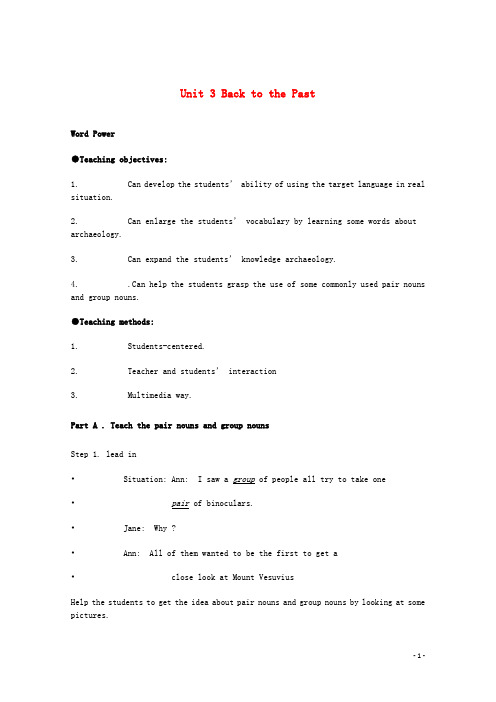
Unit 3 Back to the PastWord Power●Teaching objectives:1. Can develop the students’ ability of using the target language in real situation.2. Can enlarge the students’ vocabulary by learning some words about archaeology.3. Can expand the students’ knowledge archaeology.4. .Can help the students grasp the use of some commonly used pair nouns and group nouns.●Teaching methods:1. Students-centered.2. Teacher and students’ interaction3. Multimedia way.Part A . Teach the pair nouns and group nounsStep 1. lead in• Situation: Ann: I saw a group of people all try to take one•pair of binoculars.• Jane: Why ?• Ann: All of them wanted to be the first to get a• close look at Mount VesuviusHelp the students to get the idea about pair nouns and group nouns by looking at some pictures.e.g. a pair of sacksa flock of birdsa herd of horsesStep 2. Label each picture, using an expression including a word in the box.Then summarize the use of pair nouns.• The word pair is used for many things that are found in twos or have two parts. It is placed in front of the plural form of a noun.Step 3. Label each picture, using an expression including a word in the box.Then summarize the use of group nouns.• A group noun is used to refer to people or things as a group.• We can also use the words family, crowd and team to refer to people who appear collectively.Step 4. competition.Now let’s have a c ompetition and see how much you know about group nounsand pair nouns?Part B. Learn some words and information about archaeology.Step 1.Show a picture of a famous archaeologist and ask questions.Who is he ?What is he ?Where is he?What is he doing?Step 2. Label each picture, using an expression and words and information about archaeologyStep 3 Students read Part A carefully, paying attention to the word in blue.Step 4 .Students read and fill in the blanks of Part B.Step 5. Students have a group discussion•Which subject are you interested in?•What are you going to be when you grow upStep 6. Ask the students to write out as many words as possible. Task 3. Homework1. Remember the pair nouns and group nouns.2. Preview the grammar.。
英语:unit3back to the past-project教案(牛津译林版必修3)

Unit 3 Back to the pastProject Creating an illustrated time chartPart AStep I ReadingRead the article and try to get the main idea of each paragraphParagraph 1 Main events in Rome and China between 753 BC and 479 BC.Paragraph 2 Similarities between China and Rome during the Han Dynasty.Paragraph 3 Both Rome and China influenced other areas between 212 BC and 100 BC.Paragraph 4 Rome and China had a difficult time in the following hundred years.Read the article again and answer the following questions:1. When did Rome become a republic and what happened in China then?2. When was China united and by whom?3. Which city did Han Dynasty have as its capital? Where is it now?4. What did China and Rome have in common during the Han Dynasty?5. When Silk Road was in use? And what was it used for?6. When did the trade between China and Rome begin? What goods were traded?7. When did Han Dynasty fall and what did it result in?8. When was Roman Empire ended? Was it the same story for China?Step 2 Time chartRead the time chart carefully and answer the following questions:1. What happened in both China and Rome in the year 509 BC?2. What about the year 27 BC?3. When was Confucius born?4. How long did the Han Dynasty last?Conclusion:What is a time chart?A time chart should be a chart marked with time periods and important events that take place in certain time periods.Step 3 Language points• 1. Not only was Rome a city and a republic, but it was also to become the capital of one of the•largest empires in history. 罗马不仅是一个城市和一个共和国,它还是历史上最大帝国的首都。
高中英语 Unit3back to the past-reading教案 牛津译林版必修3
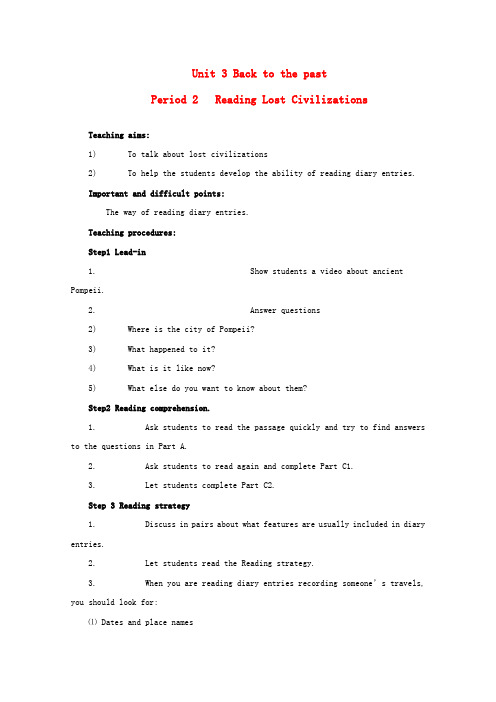
Unit 3 Back to the pastPeriod 2 Reading Lost CivilizationsTeaching aims:1) To talk about lost civilizations2) To help the students develop the ability of reading diary entries.Important and difficult points:The way of reading diary entries.Teaching procedures:Step1Lead-in1. Show students a video about ancient Pompeii.2. Answer questions2) Where is the city of Pompeii?3) What happened to it?4) What is it like now?5) What else do you want to know about them?Step2 Reading comprehension.1. Ask students to read the passage quickly and try to find answers to the questions in Part A.2. Ask students to read again and complete Part C1.3. Let students complete Part C2.Step 3 Reading strategy1. Discuss in pairs about what features are usually included in diary entries.2. Let students read the Reading strategy.3. When you are reading diary entries recording someone’s travels, you should look for:⑴ Dates and place n ames⑵Facts and historical information⑶Personal feelings and opinions4. Answer questions according to the text.1 What happened to Pompeii in August AD 79?2. How was the buried city discovered?3. What were the stepping stones along the road in Pompeii used for?4. Why was Loulan an important city about 2,000 years ago?5. How do many people think Loulan disappeared?6. According to the last sentence, how did the author feel about the loss of Loulan?5. Find out the facts and historical information about the two cities.Step 4 Discussion1. Is it useful for people to study things from the past? Why or why not?2. Since as long ago as 1553 people have said, ‘History repeats itself.’ What do you think this saying means? Do you agree with it? Why or why not?Step 5Homework.1. Read the passage carefully and review the new words and phrases.2. Make a summary of the text.Period 3 Reading (2)Teaching Objectives:1) To understand the text better2) To master some useful words and expressionsImportant and difficult points:Some useful words and expressionsTeaching procedures:Step 1 Check the homework.Step 2 Complete the summary with proper words.Both Pompeii in ________and Loulan in China became ____ ________ about 2000 years ago. Pompeii was ________ in the 8th century BC and was _____ _______ by the Romans in 89BC. On 24th Aug.AD79, Mount Vesuvius _________ and the city were _______ __________. Loulan was a _________ _________ on the Silk Road. It disappeared under the ________. There are just a few _________ left. Some _________, such as coins and painted pots, was found.Step 3 language study• 1. A British society arranged for ten high school students from different countries to go on a cultural expedition to sites of lost civilizations. arrange v. 安排,筹划,整理,布置• arrange + n. + for + n. 为…安排…• arrange + for + n. + to do 安排…做…• arrange + (with + n.) + to do (与人)约定干…• arrange + that clause(从句用should + v.) 商定…, 安排…•I arranged to meet him at 6 o’clock.•我约定在6点钟跟他见面.• The secretary ______ ______ the manager.•秘书替我向经理预约.•I’ve _______ for him ________ her.•我已安排他跟她见面.• He arranged that the meeting _______ off for a week.•他安排把会议延后一星期召开.• 2. I am representing Canada. I feel lucky to have won a place on this trip.•我代表加拿大。
高中英语unit3backtothepast-task教案牛津译林版必修3
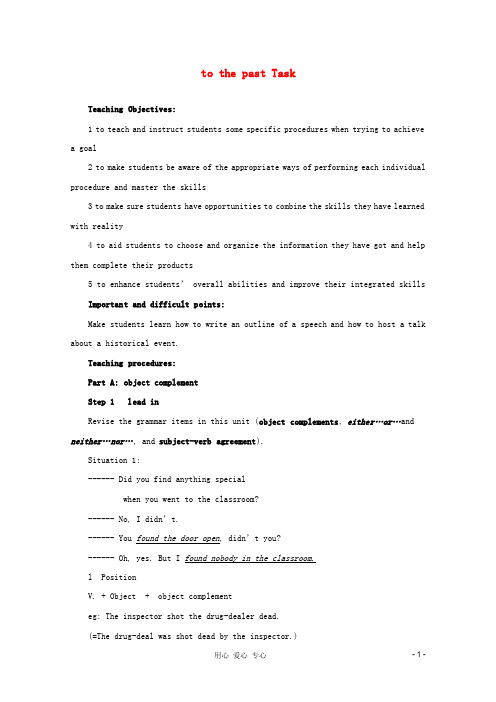
to the past TaskTeaching Objectives:1 to teach and instruct students some specific procedures when trying to achievea goal2 to make students be aware of the appropriate ways of performing each individual procedure and master the skills3 to make sure students have opportunities to combine the skills they have learned with reality4 to aid students to choose and organize the information they have got and help them complete their products5 to enhance students’ overall abilities and improve their integr ated skillsImportant and difficult points:Make students learn how to write an outline of a speech and how to host a talk about a historical event.Teaching procedures:Part A: object complementStep 1 lead inRevise the grammar items in this unit (object complements, either…or…and neither…nor…, and subject-verb agreement).Situation 1:------ Did you find anything specialwhen you went to the classroom?------ No, I didn’t.------ You found the door open, didn’t you?------ Oh, yes. But I found nobody in the classroom.l PositionV. + Object + object complementeg: The inspector shot the drug-dealer dead.(=The drug-deal was shot dead by the inspector.)Step 2 learn the usage of object complementSituation 2:------ What do you think about her performance?------ We consider that her performance is a big success.We consider her performance a big success. )------ What do people think about dogs?------ People believe that dogs are honest.( People believe dogs to be honest. )l Usage An object complement , which gives information about the object, can be a noun, a noun phrase, an adjective,a to-infinitive, a bare infinitive, or a prepositional phrase.Step 3 Practise in oject complement.------What do you think about Harry Potter?------I find it ________________________.------What happened to the man?------The man was kept _________.Step 4: Use the words and phrases in the box to complete the following• Professor Zhang is a great archaeologist. His work has made the archaeological discovery of Loulan (1)_______________. We believe him(2)__________________________ as his work seems never ending.• We have all found Professor Zhang (3)______________. He took the time to answer all our questions and his answers were very wise. We have found him(4)_________________.• I walked in the desert with the other students this afternoon and we found the desert (5)_______________. The heart almost drove me (6)_____________even though I was wearing very thin cotton trousers to keep me (7)__________. It seems that I shouldn’t have brought all those thick clothes with me. I should have leftthem(8)____________________.Part B: either…or and neither … norStep 1:the use of either …or and nether …norSituation------ I have got one ticket for Liu Xiang’s 110mhurdle race to be held in Nanjing._______ you _____ your desk-mate can have it.------ Is it on Saturday or on Sunday?------ It is on next Monday.------ Oh, what a pity. I am afraid __________ I ____ my desk-mate can enjoy it.Step 2: summary:(1) Either … or…can be used to express the idea of alternatives.eg: You can choose either A or B, which means you have twochoices, i. e, you can choose any one of the two.(2) Neither … nor…can be used to join two negative ideas together.eg: Neither A nor B is proper in question one, which meansA is not proper, andB is not proper either.§ Situation------ Whose fault is it? ( not yours / not mine )------ It is neither your fault nor mine. It’s your friend Jack’s fault.Part C: Subject-verb agreementStep 1: Practise and summarize:Fill in the blanks with the right verb forms:1.The people’s republic of China _____(be) founded in 1949.2.The food they offered on the plane ______(be) delicious.The verb should be singular if the subject is.3.Two hours_____(be) not enough for so much homework.4.Twenty thousand dollars_____(be) a large amount of money to me.The verb should be singular if the subject is a phrase of measurement,money or distance.All of us _____ __ ( attend) the lecture about Pompeii .Most of the lecture ______(be) about how the ancient city was discovered.I spent only 30 yuan buying books and the rest of money_______(be) spent on my food.When the subject is all of/ some of /half of+noun/pronoun, the verb agrees with the noun and pronoun.An expert with some assistants_____ (be) sent to work in Gansu Province.No on except two teachers________( know) the secret.Xiao Ming as well as his parents_____(be) interested in music.When the subject followed by with/ together with/as well as/, the verb agrees with the subject.Either the team leader or the guides _____ (be) looking after the students.Neither noodles nor rice______(be) delicious today.Either you or the headmaster_______(be) to hand out prizes to those gifted students at the meeting.Not only you but also I_______(be) puzzled at her worried look.When neither…nor/ either…or/ not only…but also…are used to join the sub jects of a sentence, the verb agrees with the subject closest to it.His family_____(be ) to move to the countryside next month.His family _____all (be) fond of popular music.Our school ______(be) a key school in Jiangsu Province.Our school ______doing (do) morning exercises now on the playground.When the subject is a group noun like: class/ family/ government/ team… , we use a singular verb if the noun identifies a singular or unit, or a plural verb if it identifies a number of individuals.Step 2: Exercise.1. Each of you ______ responsible for the accident.a. amb. bec. isd. are2. Each man and woman ______ the same rights.a. hasb. havec. hadd. is having3. Every means ______ tried but without much result.a. has beenb. have beenc. ared. is4. There ______ in this room.a. are too much furnitureb. is too many furnituresc. are too much furnituresd. is too much furniture5. The manager or his assistant ______ planning to go.a. wereb. arec. wasd. be6. Not only I but also David and Iris ______ fond of playing basketball.a. amb. isc. ared. was7. Neither Tom nor his parents ______ at home.a. isb. arec. hasd. was8. Either the dean or the principal ______ the meeting.a. attends b . Attendc. are attendingd. have attended9. ______ was wrong.a. Not the teacher but the studentsb. Both the students and the teacherc. Neither the teacher not the studentsd. Not the students but the teacher10. “______ twenty dollars a big sum to her?”“I suppose so.”a. Will beb. Isc. Ared. WereHomework:Do exercise in the work book.。
英语:Unit 3《Back to the Past》教案-welcome to the unit(牛津译林版必修3)
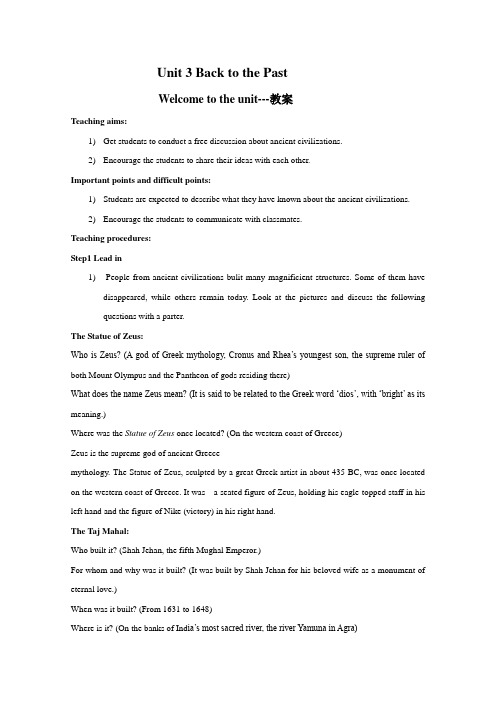
Unit 3 Back to the PastW elcome to the unit---教案Teaching aims:1)Get students to conduct a free discussion about ancient civilizations.2)Encourage the students to share their ideas with each other.Important points and difficult points:1)Students are expected to describe what they have known about the ancient civilizations.2)Encourage the students to communicate with classmates.Teaching procedures:Step1 Lead in1) People from ancient civilizations bulit many magnificient structures. Some of them havedisappeared, while others remain today. Look at the pictures and discuss the following questions with a parter.The Statue of Zeus:Who is Zeus? (A god of Greek mythology, Cronus and Rhea’s youngest son, the supreme ruler of both Mount Olympus and the Pantheon of gods residing there)What does the name Zeus mean? (It is said to be related to the Greek word ‘dios’, with ‘bright’ as its meaning.)Where was the Statue of Zeus once located? (On the western coast of Greece)Zeus is the supreme god of ancient Greecemythology. The Statue of Zeus, sculpted by a great Greek artist in about 435 BC, was once located on the western coast of Greece. It was a seated figure of Zeus, holding his eagle-topped staff in his left hand and the figure of Nike (victory) in his right hand.The Taj Mahal:Who built it? (Shah Jehan, the fifth Mughal Emperor.)For whom and why was it built? (It was built by Shah Jehan for his beloved wife as a monument of eternal love.)When was it built? (From 1631 to 1648)Where is it? (On the banks of Ind ia’s most sacred river, the river Yamuna in Agra)The Mughal Emperor Shah Jahan built the Taj Mahal on the banks of the river Yamuna as a tomb for his wife. It was built in 22 years (1631 to 1653) by 20,000 workmen. The building is made of white marble . A beautiful garden surrounds the Taj Mahal. In front of the main entrance to the building there is Taj Mahal in the reflection from the water.The Hanging Gardens:Who built it? (King Nebuchadnezzar, who ruled ancient Babylon for dozens of years)Why did it appear to be ‘hanging’ in the sky? (It looked so because it was constructed entirely on the roofs of a building, with a lot of trees surrounding it.)Why was it built? (To cheer up Nebuchadnezzar’s wife who was said to be very homesick)King Nebuchadnezzar Ⅱ of Babylon(605-562 BC) built the Hanging Gardens to cheer up his wife who missed the flowers and trees of her homeland. The garden got its name because it was built entirely on the roofs of a building ,with a lot of trees surrounding it. This gave the impression that it was hanging in the sky.The Potala Palace:Where is it located? (On the Red Hill in the Lhasa Valley of Tibet, China)When was it rebuilt? (In the 17th century)What was it used as? (The residence of the Dalai Lamas since the 7th century, as well as the religious and political centre of old Tibet)Potala Palace is located on “Red Hill” in Lhasa. It was originally built in the 640’s, during the reign of King Songtsan Gampo. The 13-story palace stands 117 meters high and covers an area of 130,000 square meters. It is divided into two sections, the Red Palace and the White Palace. It was used as the residence of the Dalai Lamas since the 7th century, as well as the religious and political centre of old Tibet.Step3 Group discussion1.What other ancient civilizations do you know about?2 Do you think it is important to protect cultural heritage? Why or why not? Do you have any suggestions on how to protect it?Sample answers1.yes , I have the habit of visting museums when some good valuable things are on display there. I think I really enjou the beauty of the designs, the colours and even the shapes of them , which can take me back to the years long ago and I can a learn a lot about the past2.yes , in my opinion, history it is very important to protect cultural heritage, because we can learn a lot from the history, the economy, the politics and the Living style of the past. Here are some suggestions about how to protect cultural geritage. First, we need firm laws to protect it. Then ,substantial measures should be taken to rescue and protect cultural relics. Lastly. The importance of protecting our history should be introduced to our children as early as possible.Step 4Homework : Finish the exercise on page110 and preview reading .。
湖南省茶陵县高中英语Unit3BacktothepastProject教案牛津译林版必修3
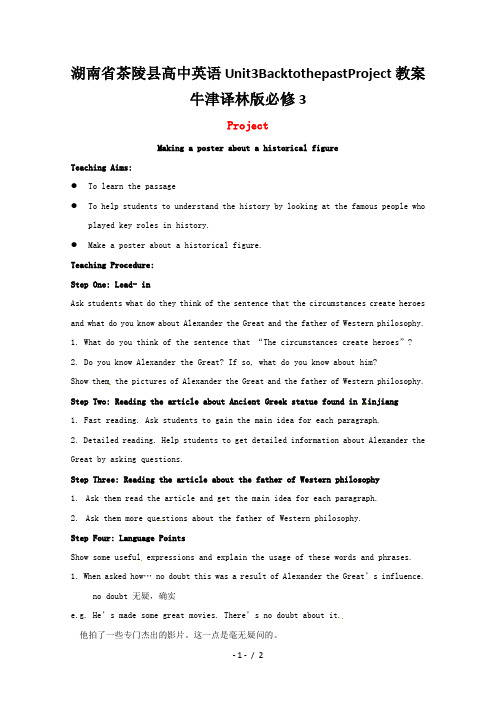
湖南省茶陵县高中英语Unit3BacktothepastProject教案牛津译林版必修3ProjectMaking a poster about a historical figureTeaching Aims:●To learn the passage●To help students to understand the history by looking at the famous people whoplayed key roles in history.●Make a poster about a historical figure.Teaching Procedure:Step One: Lead- inAsk students what do they think of the sentence that the circumstances create heroes and what do you know about Alexander the Great and the father of Western philosophy.1. What do you think of the sentence that “The circumstances create heroes”?2. Do you know Alexander the Great? If so, what do you know about him?Show them the pictures of Alexander the Great and the father of Western philosophy. Step Two: Reading the article about Ancient Greek statue found in X injiang1. Fast reading. Ask students to gain the main idea for each paragraph.2. Detailed reading. Help students to get detailed information about Alexander the Great by asking questions.Step Three: Reading the article about the father of Western philosophy1.Ask them read the article and get the main idea for each paragraph.2.Ask them more que stions about the father of Western philosophy.Step Four: Language PointsShow some useful expressions and explain the usage of these words and phrases. 1. When asked how… no doubt this was a result of Alexander the Great’s influence. no doubt 无疑,确实e.g. He’s made some great movies. There’s no doubt about it.他拍了一些专门杰出的影片。
高三英语 专题复习 Unit 3 Back to the past(第1课时)教案 牛津译林版必修3
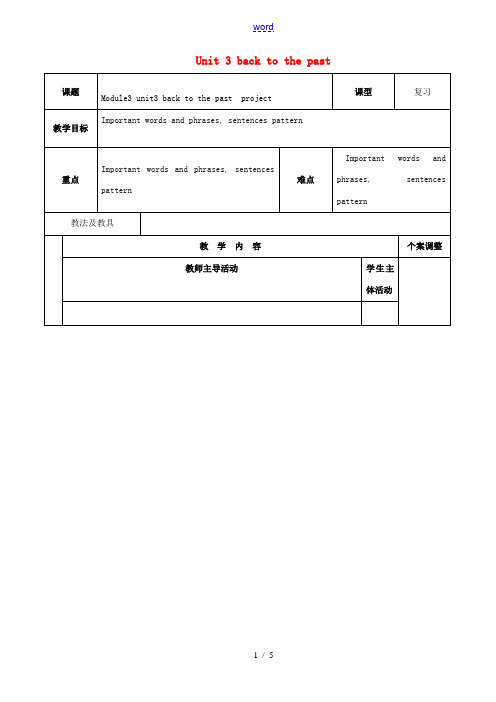
Unit 3 back to the past知识探究:I don’t doubt that he is honest/his honesty. 我不怀疑他是诚实的。
Do you doubt that he will give us a hand? 你怀疑他能否给我们帮助? There is no doubt that he will win the prize. 毫无疑问他会获奖。
There is some doubt whether he will e on time. 他是否能准时来还有疑问。
归纳整理:I doubt whether/if...我怀疑是否…I don’t doubt that.../I have no doubt that... 我不怀疑…There is no doubt about sth./ that clause…是毫无疑问的There is some doubt whether...对…有些疑问without doubt无疑地in doubt (about)不确定题练落实:A) 1. We don’t doubt ________ he can do a good job of it.A. thatB. ifC. whatD. whetherB) 2. Some researchers believe that there is no doubt _______ a cure for AIDS will be found.A. whichB. thatC. whatD. whetherD) 3. I don’t doubt ______ he took the first place in his class, but I do doubt _____ he will succeed in the end.A. if; thatB. but that; whichC. whether; whetherD. that; whether联想拓宽:doubt作动词用后接宾语从句时,肯定句中用whether或if引导从句,在否定句和疑问句中用 that引导从句。
英语:Unit3Backtothepast学案(牛津译林版必修3).docx
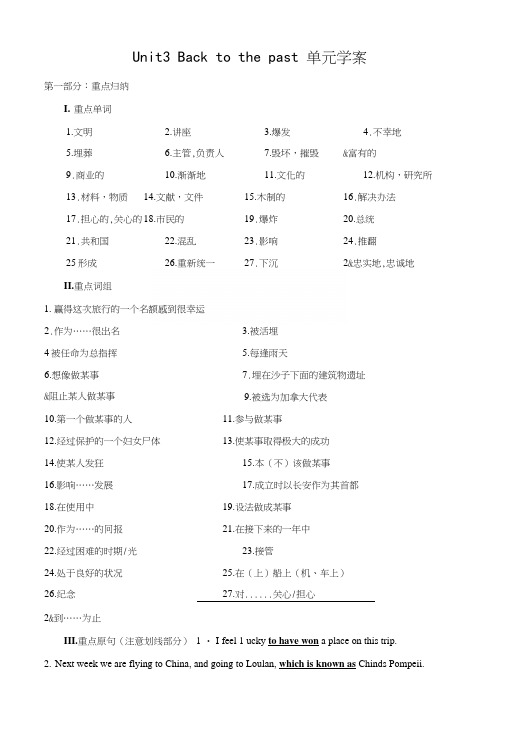
Unit3 Back to the past 单元学案第一部分:重点归纳I.重点单词1.文明2.讲座3.爆发4.不幸地5.埋葬6.主管,负责人7.毁坏,摧毁&富有的9.商业的10.渐渐地11.文化的12.机构,研究所13.材料,物质14.文献,文件15.木制的16.解决办法17.担心的,关心的18.市民的19.爆炸20.总统21.共和国22.混乱23.影响24.推翻25形成26.重新统一27.下沉2&忠实地,忠诚地II.重点词组1.赢得这次旅行的一个名额感到很幸运2.作为……很岀名3.被活埋4被任命为总指挥 5.每逢雨天6.想像做某事7.埋在沙子下面的建筑物遗址&阻止某人做某事9.被选为加拿大代表10.第一个做某事的人11.参与做某事12.经过保护的一个妇女尸体13.使某事取得极大的成功14.使某人发狂15.本(不)该做某事16.影响……发展17.成立时以长安作为其首都18.在使用中19.设法做成某事20.作为……的冋报21.在接下来的一年中22.经过困难的时期/光23.接管24.处于良好的状况25.在(上)船上(机、车上)26.纪念27.对......关心/担心2&到……为止III.重点原句(注意划线部分)1 ・ I feel 1 ucky to have won a place on this trip.2.Next week we are flying to China, and going to Loulan, which is known as Chinds Pompeii.3.Unfortunately, all the people were buried alive, and so was the city.4.The city was forgotten for many years until the 18lh century.5.Fiorelli was made director of the Pompeii dig.6.So you didn,t have to step in the mud in the streets on rainy days!7.Il is believed by many people to have been gradually covered over by sandstorms from AD200...8.Sven found the remains of buildings buried under the sand・9.Even that didn't prevent the city from bein乂buried by sand-一What a pity!10.1 was so excited to be picked to represent Canada.11.In 1980 I was involved in discovering the preserved body of a woman.12.His work has made the discovery of Loulan a huge success.13・ Not only w as Rome a city and a republic, but it was also to become the capital of one of the largest empires in history.14.The Han Dynasty was founded with Chang^an as its capital city.15.What is interesting is that the other largest city was Rome.16.Chinese people managed to travel further, introducing silk, china, etc.17.In return for silk. China received wine, spices, wool and other goods・18・ In the following hundred years both Rome and China had a difficult time.第二部分:练习1.单项选择1 ・ We dicing expect that Sara was made __ of the Students9 Union.A.chairmanB. a chairman C・ the chairman D・ chairmen2.The noise of the planes taking off and landing time and time again nearly ________ t he peoplearound the airport mad.A. leftB. keptC. droveD. caused3.The visiting guests sent us some of the pictures drawn by the students of theirs schools, and wesent them some of our calligraphy ___ .A. in return B・ in turn C. by turn D. for return4.The general manager has to retire due to his illness. Who do you think will ____ the business?A. take inB.take up C・ take on D. take over5.Mike woke up to find himself ______ by flowers, which he later found out came from the_____ villages.A. surrounding; surroundedB. surrounded; surroundingC.surrounded; suiTOunded D・ suirounding; suiTOunding6.We should never forget the days ___ China was invaded and many people were buried _____ ・A. when; liveB. which; aliveC. when; aliveD. which; living7.The government has taken some measures to prevent more trees from ____ ・A. cutting downB. cut down.C. being cut downD. been cut down&Yesterday evening I tried to call you, but I couldn't get through as the telephone was always inA. needB. use C・ case D. addition9.Now _____ as a hero for the journey into outer space, Yang Liwei has earned much respect from people all over the world ・A. knowingB. being knownC・ known D. having known10.The government is considering the environment-friendly plan which some scientists would like to see _____ soon.A. to be carried outB. be carried outC. carrying out D・ carried out1 l.A cook will be immediately fired if he is found ____ in the kitchen.A・ smoke B・ smoking C. to smoke D・ smoked12.The murder was brought in, with his hands ____ behind his back.A. being tiedB. having tied C・ to be tied D. tied13.Either you or the headmaster ___ the prize to these gifted students at the meeting.A・ is handing out B. are to hand outC. are handing outD. is to hand out14.0ne-third of the area ______ covered with green trees. About seventy percent of the trees_____ been planted ・15.Having a trip abroad is certainly good for the old couple, but it remains ____ whether they willenjoy it.A. to seeB. Io be seenC. seeingD. seen11.单词拼写I• Many famous buildings such as the Great Wall and the Summer Place can represent the an cient c _________ of China.2.The garden that was once so beautiful was d __________ in the flood.3.Since the law of wildlife protection came into effect, the number of the milu deer has growng ____________ year by year.4.Manhattan is well known as the c ___________ centre of America ・5.He grew up in a w __________ family, so he knows nothing about the life of the poor.6.Many American p ____________ s erved in Congress before they have the highest politicalpositio n.7.The _________ (残留物)of lunch were still on the table.8.He committed the crime under the _________ (影响)of a strong passion.9・ The party is in complete _______________ (7昆舌L) after its election defeat.10.There are some ___________ (相似处)between the two poets.II• America _______________ (宣布)war on Japan in 194L12._____________ (不幸地),Karen got seriously injured in a car accident on her way home.III.翻译句子1.1 consider myself __________________________________ (很幸运有机会参观印度)2.________________________________________ (他烟酒不沾),but is still in bad health.3.我从公共汽车上下来时,发现钱包被偷了。
英语ⅲ牛津译林版unit3backtothepast名师教案
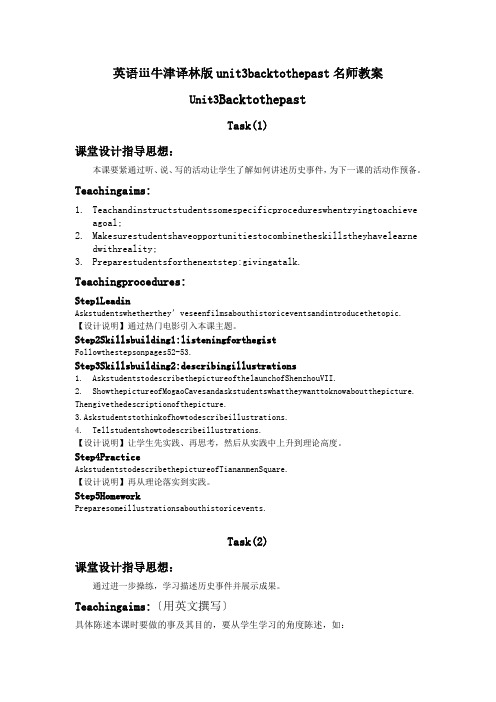
英语ⅲ牛津译林版unit3backtothepast名师教案Unit3BacktothepastTask(1)课堂设计指导思想:本课要紧通过听、说、写的活动让学生了解如何讲述历史事件,为下一课的活动作预备。
Teachingaims:1.Teachandinstructstudentssomespecificprocedureswhentryingtoachieveagoal;2.Makesurestudentshaveopportunitiestocombinetheskillstheyhavelearnedwithreality;3.Preparestudentsforthenextstep:givingatalk. Teachingprocedures:Step1LeadinAskstudentswhetherthey’veseenfilmsabouthistoriceventsandintroducethetopic. 【设计说明】通过热门电影引入本课主题。
Step2Skillsbuilding1:listeningforthegistFollowthestepsonpages52-53.Step3Skillsbuilding2:describingillustrations1. AskstudentstodescribethepictureofthelaunchofShenzhouVII.2. ShowthepictureofMogaoCavesandaskstudentswhattheywanttoknowaboutthepicture. Thengivethedescriptionofthepicture.3.Askstudentstothinkofhowtodescribeillustrations.4.Tellstudentshowtodescribeillustrations.【设计说明】让学生先实践、再思考,然后从实践中上升到理论高度。
高中英语Unit3BacktothepastProject教学设计1牛津译林版必修3
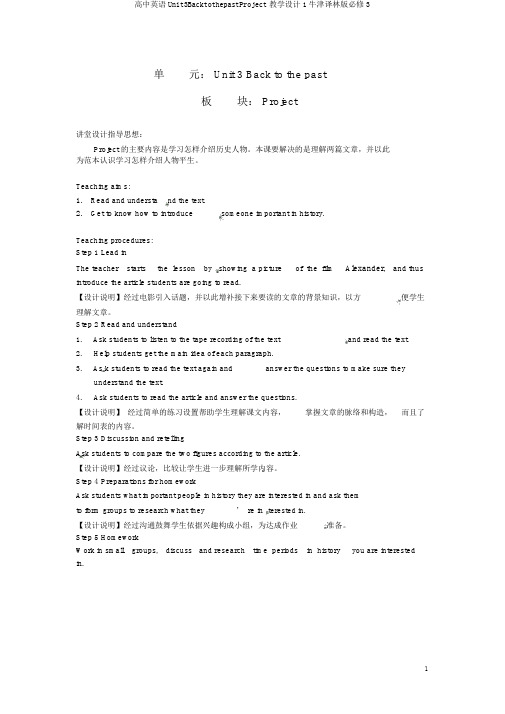
高中英语Unit3BacktothepastProject教学设计1牛津译林版必修3单元: Unit 3 Back to the past板块: Project讲堂设计指导思想:Project 的主要内容是学习怎样介绍历史人物。
本课要解决的是理解两篇文章,并以此为范本认识学习怎样介绍人物平生。
Teaching aims:1.Read and understa nd the text.2.Get to know how to introduce someone important in history.Teaching procedures:Step 1 Lead inThe teacher starts the lesson by showing a picture of the film Alexander,and thusintroduce the article students are going to read.【设计说明】经过电影引入话题,并以此增补接下来要读的文章的背景知识,以方便学生理解文章。
Step 2 Read and understand1. Ask students to listen to the tape recording of the text and read the text.2.Help students get the main idea of each paragraph.3. As k students to read the text again and answer the questions to make sure theyunderstand the text.4.Ask students to read the article and answer the questions.【设计说明】经过简单的练习设置帮助学生理解课文内容,掌握文章的脉络和构造,而且了解时间表的内容。
- 1、下载文档前请自行甄别文档内容的完整性,平台不提供额外的编辑、内容补充、找答案等附加服务。
- 2、"仅部分预览"的文档,不可在线预览部分如存在完整性等问题,可反馈申请退款(可完整预览的文档不适用该条件!)。
- 3、如文档侵犯您的权益,请联系客服反馈,我们会尽快为您处理(人工客服工作时间:9:00-18:30)。
Unit 3 Back to the pastReading Lost CivilizationsReading (2)Teaching aims:1)To talk about lost civilizations2)To help the students develop the ability of reading diary entries.Important and difficult points:The way of reading diary entries.Teaching procedures:Step 1Lead-in1.Show students a video about ancient Pompeii.2.Answer questions2)Where is the city of Pompeii?3)What happened to it?4)What is it like now?5)What else do you want to know about them?Step 2 Reading comprehension.1.Ask students to read the passage quickly and try to find answers to the questions in Part A.2.Ask students to read again and complete Part C1.3.Let students complete Part C2.Step 3 Reading strategy1.Discuss in pairs about what features are usually included in diary entries.2.Let students read the Reading strategy.3.When you are reading diary entries recording someone’s travels, you should look for:⑴Dates and place names⑵Facts and historical information⑶Personal feelings and opinions4.Answer questions according to the text.1 What happened to Pompeii in August AD 79?2. How was the buried city discovered?3. What were the stepping stones along the road in Pompeii used for?4. Why was Loulan an important city about 2,000 years ago?5. How do many people think Loulan disappeared?6. According to the last sentence, how did the author feel about the loss of Loulan?5.Find out the facts and historical information about the two cities.Step 4 Discussion1.Is it useful for people to study things from the past? Why or why not?2.Since as long ago as 1553 people have said, ‘History repeats itself.’ What do you think this saying means? Do you agree with it? Why or why not?Step 5Homework.1. Read the passage carefully and review the new words and phrases.2. Make a summary of the text.Reading (2)Teaching Objectives:1)T o understand the text better2)T o master some useful words and expressionsImportant and difficult points:Some useful words and expressionsTeaching procedures:Step 1 Check the homework.Step 2 Complete the summary with proper words.Both Pompeii in ________and Loulan in China became ____ ________ about 2000 years ago. Pompeii was ________ in the 8th century BC and was _____ _______ by the Romans in 89BC. On 24th Aug.AD79, Mount Vesuvius _________ and the city were _______ __________. Loulan was a _________ _________ on the Silk Road. It disappeared under the ________. There are just a few _________ left. Some _________, such as coins and painted pots, was found.Step 3 language study• 1. A British society arranged for ten high school students from different countries to go on a cultural expedition to sites of lost civilizations. arrange v. 安排,筹划,整理,布置•arrange + n. + for + n. 为…安排…•arrange + for + n. + to do 安排…做…•arrange + (with + n.) + to do (与人)约定干…•arrange + that clause(从句用should + v.) 商定…, 安排…•I arranged to meet him at 6 o’clock.•我约定在6点钟跟他见面.•The secretary ______ ______ the manager.•秘书替我向经理预约.•I’ve _______ for him ________ her.•我已安排他跟她见面.•He arranged that the meeting _______ off for a week.•他安排把会议延后一星期召开.• 2. I am representing Canada. I feel lucky to have won a place on this trip.•我代表加拿大。
能赢得这次旅行的资格我感到幸运。
•⑴represent 在这里是‘代表’的意思:;如;•The union represents over 200,000 teachers.•工会代表着20余万教师的利益。
•The competition attracted 500 athletes _____ 8 different countries.•这次比赛吸引了代表8个国家的500多名运动员。
•represent还表示:维护…的利益;体现;象征等意思。
•Those comments do not represent the views of us all.•这些言论不足以体现我们所有人的看法。
•Each color on the chart ______ a different _______ .•图表中的每一种颜色都代表一个不同的部门。
•They ___________ their concerns to the authorities.•他们向当局陈述了他们关心的问题。
•. I am representing Canada. I feel lucky to have won a place on this trip.我代表加拿大。
能赢得这次旅行的资格我感到幸运。
•⑵win a place 意思是“赢得资格”如;•She will someday win a place in music's hall of fame.•她将来会在音乐方面获致不朽的成就。
•She has _____ _____ ______ in the Olympic team.•她已获得奥运代表队的队员资格。
•He __ ____ ___ in the first team.•他失去了甲级队员的资格。
• 3. The city was founded in the 8th century BC.•found 意思是“建立;创建; 创办。
”如;•Her family ______ the college in 1895.•她家族1895年创办了这所学院。
•The town was founded by English settlers in 1790.•这座城市是英国移民于1790建立的。
•Their marriage __ ___ on love and mutual respect.•他们的婚姻建立在爱情和相互尊重的基础上的。
•注意found; form; organize.的区别。
• 4. In 89 BC, the Romans took over Pompeii.公元前89年,罗马人接管了庞贝城。
•take over的意思是“接任;接管;接收”如;•You watch them until ten o'clock, and then I'll take over.•你看他们看到10点钟,然后我接班。
•CBS records ____ ___ _____ by Sony.•哥伦比亚广播公司的唱片公司已被索尼公司收购。
•When Mr. Green retired, his son ____ ___ the business from him.•格林先生退休后由他儿子接管他的生意。
